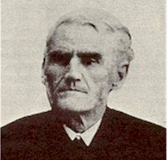Author: Hiding in Thee
“It must be said of this hymn that it was the outgrowth of many tears, many heart-conflicts, and soul-yearnings, of which the world can know nothing. The history of many battles is behind it.” (William Orcutt Cushing)
The Origins of the Hymn “Hiding in Thee”
Some hymns arise out of profound joy, while others are born from struggle and sorrow. “Hiding in Thee” belongs to the latter. It is a hymn that speaks to the soul’s longing for refuge in God when life’s storms rage the fiercest. Written in the late nineteenth century, it has endured because it expresses a universal cry of the Christian heart: to find shelter in the Lord when trials overwhelm.
The Writer: William O. Cushing
The hymn’s text was written by William Orcutt Cushing (1823–1902), a Methodist minister from Hingham, Massachusetts. Cushing devoted much of his life to pastoral ministry in New York state. He was known as a kind, humble man with a deep love for both his congregants and the Lord.
Cushing’s ministry was marked by sincerity and compassion, but his later years were filled with physical difficulty. Around the age of fifty, he suffered an illness that left him with a permanent loss of his voice. This affliction forced him to step aside from the pulpit, effectively ending the pastoral ministry to which he had dedicated his life.
Yet even in this hardship, Cushing sought to serve the Lord. Unable to preach, he turned to writing hymns as a way of continuing his ministry. In time, he composed more than 300 hymn texts, many of which were set to music by prominent composers of his day. His words, though often simple, carried the weight of personal trial and trust in God’s sustaining grace.
The Circumstances Behind the Hymn
The inspiration for “Hiding in Thee” came during a season of personal grief. Cushing himself recounted that he was seeking refuge from sorrow and the burdens of life when the words of the hymn began to form in his heart. His experience of pain, loss, and helplessness drew him closer to the reality of God as a sheltering refuge.
The imagery he employed—“O safe to the Rock that is higher than I”—echoes the language of the Psalms, particularly Psalm 61:2: “Lead me to the rock that is higher than I.” The hymn’s repeated emphasis on hiding in God reflects a faith that, though tested, found solace in divine protection.
The Composer: Ira D. Sankey
The words of Cushing found their enduring melody through the work of Ira David Sankey (1840–1908), the famed gospel singer and musician who partnered with evangelist Dwight L. Moody. Sankey was deeply moved when he first read Cushing’s text. He recognized its potential as a hymn that could minister to the hearts of many who were struggling under life’s burdens.
Sankey composed the tune himself, giving it a tender and almost pleading quality that perfectly matched the spirit of the words. The hymn was later published in Sankey’s Gospel Hymns and Sacred Songs, where it reached congregations and revival audiences across America and beyond. Through Sankey’s voice and leadership in song, “Hiding in Thee” quickly became a favorite at revival meetings.
The Message of the Hymn
“Hiding in Thee” speaks directly to the need for refuge in God when troubles assail. Each verse builds upon this theme, describing the storms of life, the sorrows of the heart, and the temptations that threaten the soul. Yet in every case, the answer is the same: to run to Christ, the Rock of Ages, and find shelter.
The refrain—“Hiding in Thee, hiding in Thee, Thou blest Rock of Ages, I’m hiding in Thee”—reinforces the act of faith. It is not simply a declaration of doctrine but a personal testimony of trust. Cushing’s life, marked by both faithful service and physical loss, gave weight to these words. He knew firsthand what it meant to need the shelter of God’s presence.
Enduring Legacy
Since its first publication, “Hiding in Thee” has been treasured in both congregational worship and personal devotion. It has been included in numerous hymnals and has been sung in revival meetings, prayer gatherings, and private times of worship. Its enduring appeal lies in its honesty: it does not deny the reality of hardship but points directly to the One who provides shelter in the midst of it.
For many, the hymn has served as a reminder that the Christian life is not free of sorrow or trial. Instead, it is marked by a continual reliance on God’s strength. Just as Cushing turned to hymn writing when his preaching voice was silenced, so too does the hymn call believers to turn to God when life overwhelms.
Conclusion
The origins of “Hiding in Thee” reflect both the personal struggles of its author, William O. Cushing, and the musical gift of Ira D. Sankey. Born from sorrow yet filled with hope, the hymn captures the believer’s instinct to run to God for refuge. Its enduring popularity is a testament to the timeless truth it proclaims: that the Rock of Ages remains a safe hiding place for all who call upon Him.
Though Cushing’s voice was silenced, his words found new life through Sankey’s melody and the voices of countless worshippers. More than a century later, Christians still sing “Hiding in Thee” with the same assurance that inspired its creation—that in God alone is found lasting shelter and peace.
Related
Sorry, no records were found. Please adjust your search criteria and try again.
Sorry, unable to load the Maps API.

